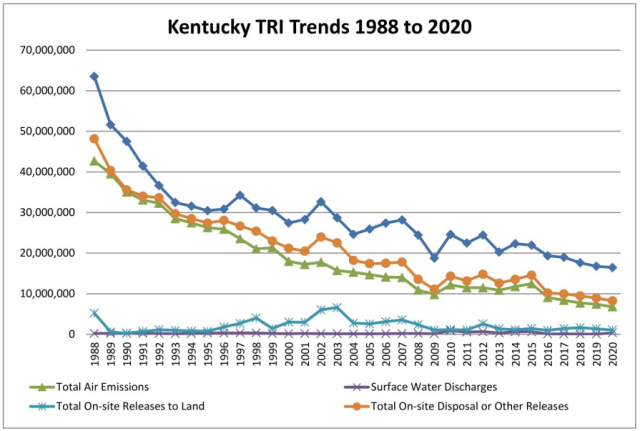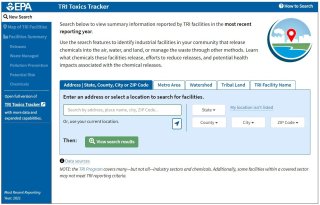TRI for Government
EPA uses Toxics Release Inventory (TRI) data to inform the scientific documents, policies and technical assistance efforts of various programs. Many other government organizations at the Tribal, federal, state and local levels also use TRI data. The TRI allows government agencies to identify sources of toxic chemical releases that may impact the health of their communities, track changes in these releases over time and prioritize efforts to reduce pollution from nearby facilities.
How Can Governments Use TRI Data?
TRI tracks the management of certain toxic chemicals that may pose a threat to human health and the environment from TRI-reporting industrial facilities. TRI tools allow for online exploration or download of all reported data and summarize information for different geographies (e.g., ZIP code, city, state), chemicals, industries and facilities.
Governments can use TRI data to:
- Identify TRI-reporting facilities that operate in an area and what chemicals they release,
- Track changes in releases and other waste management quantities over time to help measure environmental performance,
- Prioritize pollution prevention assistance efforts to facilities in an area,
- Inform siting or permitting decisions,
- Help plan for chemical-related emergencies,
- Promote public awareness of the availability of environmental information,
- Incorporate TRI data as a metric in analyses of local health and environmental conditions, and
- Inform the development of regulations, guidelines, or standards.
Tribal Governments
In 2023, there were 2,143 facilities on or within 10 miles of the lands of 250 Tribes. These facilities reported a total of 230 million pounds of releases. The TRI for Tribes webpage provides resources such as tips for exploring the TRI Tribal dashboard, summary information, and contact information. Learn more about how TRI data can support Tribes.
International Chemical Release Reporting
Pollutant Release and Transfer Registers (PRTRs) are the data collection systems that track releases of pollutants into the environment and transfers of pollutants off site for waste disposal or other management. The TRI is the U.S. PRTR system, after which many other countries have modeled their programs. Currently, at least 50 countries have fully established PRTRs or have implemented pilot programs. Learn more about international PRTRs.
Governmental Data Use Spotlights
Spotlight: U.S. Army Uses TRI Data in Sustainability Report
TRI data are one metric the U.S. Army uses to evaluate its progress toward achieving sustainability goals. The Army's 2009 sustainability report cited a reduction in pounds of chemical releases. Access the report.
Spotlight: Kentucky Publishes State-Specific TRI Analysis

State agencies often conduct assessments of chemical releases reported by facilities located within their states.
Kentucky’s Energy and Environment Cabinet publishes an annual summary and analysis of TRI data. The report highlights the top chemicals released into the air, water and land; trends in releases over time; and rankings of facilities based on quantities of releases and off-site transfers. Access the reports.
Spotlight: EPA Uses TRI Data to Evaluate Green Chemistry Practices
Various programs in the EPA use TRI data in publications, data access tools, agency reports, and pollution prevention technical assistance, among other purposes.
In a 2015 study, the EPA used TRI data to analyze pharmaceutical firms’ claims that implementation of green chemistry practices in their manufacturing processes significantly reduced the quantities of toxic chemicals used and released into the environment. Read the publication.
Learn More About Chemical Waste Management in Your Jurisdiction

For the most recent 10 years, use the TRI Toxics Tracker to learn about facilities managing chemical waste and filter by jurisdictions (e.g., Tribal, state, city).
To access data for all years, use TRI Explorer’s location-based fact sheets and other reports.

Relevant Contacts
- TRI Program Regional Coordinators: Governmental agencies concerned about toxic chemicals released from specific industrial facilities may contact the TRI Coordinator for their region.
- TRI Tribal Contacts: Find the environmental officials designated by federally recognized Tribes to receive reporting forms from TRI facilities located on the lands of federally recognized Tribes.
- EPA Tribal Program Managers: Tribes are encouraged to contact the Tribal Program Manager in their region with questions about facilities near Tribal communities.
- TRI State Contacts: Governmental agencies concerned about toxic chemical releases from specific facilities may contact their TRI State Coordinator for more information.
- Health and Environmental Agencies of U.S. States and Territories: Governmental agencies concerned about human and environmental health at the state and territory level.
- Regional Pollution Prevention Coordinators: Staff from EPA’s P2 Program can answer questions about P2 grant applications, finding technical assistance, identifying resources for businesses, and more.
- P2 Technical Assistance Providers: Find regional, state, and local pollution prevention technical assistance resources in your area.
